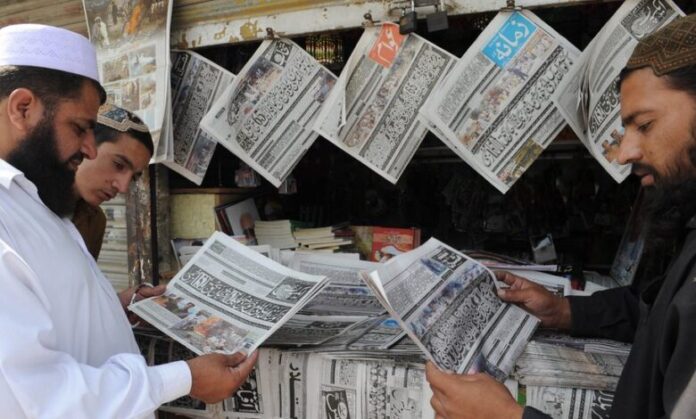
Muhammad Ghazzanfar
Mehboob Ali, a newspaper hawker in Quetta for 17 years, is facing severe financial challenges, causing significant mental distress. Desiring to quit his job, he is troubled by the lack of alternative employment opportunities. Balochistan has witnessed a 70% decline in newspaper demand, reducing Mehboob Ali’s monthly commission to a mere Rs 13,000, making it difficult to sustain a household.
Initially earning between 30,000 and 40,000 rupees per month when he started, Mehboob Ali’s income has sharply decreased over the past decade. Government offices, which once took 20 copies of various newspapers, now limit themselves to 3 to 5 copies. The advent of online news further compounds the challenges, with Mehboob Ali’s newspaper load shrinking from 380 to 65 copies for Quetta Cantt.
Decrease in “Roznama Jang” Copies
The decline is evident in newspapers like Jang, where the previous 24,000 copies in Quetta have dwindled to only 4,500. Even when combining Jang, Express, Mashreq, and local newspapers, the total of 9,000 copies falls short. With commissions as low as 3 to 5 rupees for small newspapers, Mehboob Ali laments the financial plight of the 400 hawkers relying on 9,000 copies.
Also Read: Famed Charsi Tikka Owner Arrested Again Over Indecent Video with Foreign Tourist
Abdul Aleem, a 55-year-old newspaper stall owner in Quetta, notes a drastic reduction in stalls from over 12 to just 2. The shift from news consumption to buying newspapers only on days with tenders, vacancies, and judicial advertisements contributes to the decline. Social media, the disappearance of bus stands, and the convenience of obtaining news online further impact newspaper sales.
Social Media and Changing News Content
Abdul Aleem highlights the impact of social media, noting that newspapers lack local news and are saturated with press releases and official statements.
Babrak Niaz, Chairman of Balochistan University’s Department of Mass Communication, attributes the decline in readership to the immediacy of news on social media platforms. The quality of newspapers has diminished, with the focus shifting from public issues to official statements.
Decline in Reading Trends
Babrak Niaz observes a broader societal decline in reading trends, noting that teachers in universities now provide specific material rather than entire books. Artificial intelligence has expedited information retrieval, leading today’s youth to seek quick and easy access to relevant content, further diminishing the reading process. The purpose of newspapers, once integral to public discourse, is now struggling to survive in the face of changing reader preferences.
Media Transformation: A Business Shift
Babrak Niaz asserts that journalism in Pakistan has transformed into a business rather than a mission, with a focus on advertising rather than unbiased news reporting. The impact of this shift is evident in the compromised nature of news content. Despite Balochistan University producing 50 mass media graduates annually, only a meager 5% actively pursue careers in the media sector.
Surprisingly, even graduates from Sardar Bahadur Khan Women’s University contribute minimally to the representation of women in media, with only four women reporters in Balochistan.
Striving for Authentic Journalism Standards
Manzoor Baloch, the General Secretary of the Balochistan Union of Journalists (BUJ), emphasizes the union’s commitment to authentic journalism standards. The BUJ rejects “fake newspapers” and denounces publications that rely solely on news agencies without maintaining their own reporting and photography staff.
Criticizing the practice of hiring individuals without proper pay, the union refuses membership to those not permanently employed in recognized organizations. Baloch asserts that the BUJ’s principled stance, though facing criticism, upholds journalistic values and prevents a decline in journalistic standards.
Digital Transition Challenges in Balochistan
Manzoor Baloch highlights a concerning trend in Balochistan where newspapers are slow to transition to digital media, unlike their global counterparts. He attributes this lag to the inability to falsify circulation numbers in the digital realm.
Advocating for competition, Baloch points out that while a few newspapers in Balochistan have embraced digital platforms, the majority have not, contributing to the decline of print media in the region. The BUJ has urged newspaper owners to hire staff, demanded government intervention to regulate newspapers with genuine offices and staff, and urged organizations to make sacrifices to sustain the industry.
Government’s Perspective on Unemployment and Media Challenges
Jan Achakzai, the caretaker information minister of the Balochistan government, acknowledges the challenges of unemployment across sectors, including journalism. While emphasizing the freedom of journalism in Balochistan, Achakzai calls on media institutions to provide training and opportunities for new graduates. He recognizes the financial difficulties faced by local newspaper owners due to limited government advertisements and a relatively weak private sector in Balochistan.
However, he urges newspaper owners to play a pivotal role in promoting journalism within the province, assuring them that difficulties are temporary and part of the industry’s evolution. Achakzai clarifies that advertisements are allocated based on circulation and the number of employees, with salaries considered, in newspapers, emphasizing the importance of sustaining the industry.
Note: This story is part of a Pakistan Press Foundation Fellowship.







